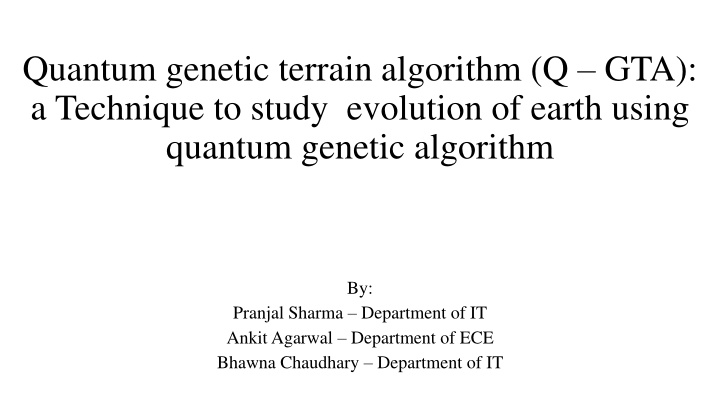



Quantum genetic terrain algorithm (Q – GTA): a Technique to study evolution of earth using quantum genetic algorithm By: Pranjal Sharma – Department of IT Ankit Agarwal – Department of ECE Bhawna Chaudhary – Department of IT
Genetic Algorithm (GA)? • Genetic is a search heuristic that is inspired by Charles Darwin’s theory of natural evolution. • It reflects the process of natural selection on the basis of survival of the fittest • Thus producing a offspring of the next generation • It basically is an evolutionary optimization algorithm • It includes 5 processes named population initialization, fitness calculation, mutation, crossover and termination condition.
Isotopic fractionation • It describes the processes that affect the relative abundances of isotopes, used in isotopic geochemistry. • It is defined as relative partitioning of the heavier and lighter isotopes between two coexisting phases in a natural systems. • There is a temperature dependency of isotopic ratio which embarks that with change in ratio changes temperature.
Modelling earths evolution • As per D. Paul the isotopes are present at multi reservoirs incorporating Sm- Nd.- Rb-Sr isotopic decay systematics. • There is a lot of transition among these reservoirs. • Not only this these isotopes moves from one channel to another eg mantle to lithosphere , mantle to atmosphere etc. • Thus studying the evolution of earth on the basis of isotopic ratio changes deriving the temperature changes of the earths different channels.
Introduction Q- GTA • Quantum genetic terrain algorithm is basically a moulded version of the GA. • It does not refer to implementing in quantum or classical version here. But depicts a generic implementation. • It consist of same 5 keys of GA moulded as per our use. • It implements the combines use of isotopic evolution and genetic evolution in the algorithm called Q-GTA.
Key points of Q-GTA • Population initialization • Genome • Chromosome • Parent Selection • Fitness Function • Mutation • Crossover • Termination condition
Algorithm • BEGIN • Generation ← 0 • Initialize pool genes as past ratio • Procedure chromosome formation (gene, channel, chromosome) • If ‘ i ’ less than ‘n’ then • End if • If gene[i].Random() channel == gene[j].Random channel then • Chromosome gene • End if • End procedure • If temp changes then • Mutation Δ chromosome Ratio • C F [fittest mutated chromosome] chromosome – Δ chromosome • End if • If movement of isotopes then • Crossover Δ chromosome Ratio • M F [fittest crossover chromosome] chromosome – Δ chromosome • End if • Steps D.b and E.b forms fittest chromosomes • Increment generation and go to step b till Generation not equals Present Generation • CPFT (Cognitive Prediction of Future Temperature) • END
Flowchart
Result
Conclusion • The 5 pillars of Q-GTA are modelled with a old set of rules but new definitions. • The basic idea of ability of GA to control and make decision are still protagonist. • Prognoses of the isotopic ratios. • The size of generation should be sufficiently large. • The number of generation should also be high to predict better. • Unavailability of proper data to analyse the crossover part of algorithm.
Future work • Use of D/H ratios to study planetary evolution. • Development of CPMT model • Cognitive approach of fitness function • Prediction of natural trends and calamities based on temperature changes
Reference • Don L. Anderson, “Isotopic evolution of the mantle: a model”, Earth and Planetary Science Letters, vol 57, pp 13-24, 1982. • Debajyoti Paul, William M. White and Donald L. Turcotte, “Modelling the isotopic evolution of the Earth”, Phil. Trans. R. Soc. Lond. A, vol. 360, pp. 2433 – 2474, 2002. • C. E. HEDGE, F. G. WALTHALL, “Radiogenic Strontium-87 as an Index of Geologic Processes”, SCIENCE, vol. 140(3572), pp. 1214-1217, 1963. • Takamoto Okudaira, Yasutaka Hayasaka, Osamu Himeno, Koichiro Watanabe, Yasuhiro Sakurai and Yukiko Ohtomo, “Cooling and inferred exhumation history of the Ryoke metamorphic belt in the Yanai district, south-west Japan: Constraints from Rb – Sr and fission-track ages of gneissose granitoid and numerical modeling”, The Island Arc, vol. 10, pp 98-115, 2001 • John H. Holland, “Genetic Algorithm and Adaptation”, Adaptive Control of Ill-Defined Systems, Plenum Press, New York, pp 317-331, 1975. • Akira Sai Toh · Robabeh Rahimi · Mikio Nakahara, “A quantum genetic algorithm with quantum crossover and mutation operations” Quantum Inf. Process, vol. 13, pp. 737-755, 2014. • L. J. Hallis, “D/H ratios of the inner Solar System”, Philosophical Transactions A, vol. 375, pp. 1-15, 2017. • J.H. Holland, “Adaptation in Natural and Artificial Systems”, Publisher: MIT Press, ISBN: 9780262275552, 1992. • D.E. Goldberg, “Genetic Algorithms in Search, Optimization and Machine Learning”, Addison-Wesley Longman Publishing Co., Inc. Boston, MA, USA, ISBN:0201157675, 1989. • Rafael Lahoz-Beltra, “Quantum Genetic Algorithms for Computer Scientists”, Journal of computers (MDPI), vol 5(24), pp 1-31, 2016 • Bart Rylander, Terry Soule, James Foster, Jim Alves-Foss, “Quantum Genetic Algorithms, Proceedings of the Genetic and Evolutionary Computation Conference”, Las Vegas, pp 1-5, 2000 • Michael L. Bottino and Paul D. Fullagar, “Whole rock rubidium-strontium age of Silurian Devonian boundary in northeastern North America”,NTRS , NASA-TM-X-57221, 1965.
Recommend
More recommend